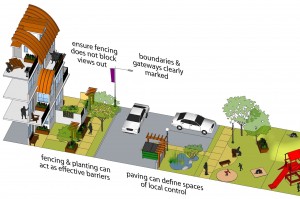
Drawing by Brendan Hurley
Copyright Brendan Hurley and Wendy Sarkissian
In many ways, the core issues associated with the social aspects of medium-density housing have not changed much in the last twenty-five years or so Repeated research identifies the same concerns, expressed by residents of medium-density housing (described below).
When people were surveyed about their housing preferences in the 1980s, 1990s or 2011, they generally report that they support the idea of building at higher densities (i.e., higher than low density housing but not necessarily high density housing) and especially what is known as medium-density housing.
They claim to understand the sustainability and health implications of the density imperatives. However, respondents tended to express the same concerns about higher density living:
Issues
- Privacy (acoustic and visual): Living in close proximity to your neighbours raises issues related to being observed (or overheard) in your own private space and observing (or hearing) others in theirs. Often privacy problems result from residents and their visitors not appreciating the constraints of medium-density living andnot modifying behaviours (such as playing music or talking loudly on balconies at night);
- Spatial requirements: Inadequate living and storage space, especially for families;
- Neighbourhood `fit’: Residents of single-family neighbourhoods worry that higher density developments will forever alter the neighbourhood character and become “concrete jungles”;
- Play and pets: Lack of play-space for children and/or pets and the suitability of higher density housing, generally, for households with small children;
- Governance: Body corporate costs and loss of personal autonomy–a growing concern as community title (strata title) forms of governance increase;
- Cost considerations: Concern that shared outdoor spaces should not be too large, thereby costing more to maintain than smaller ones (or no provision at all). Smart design is preferred as a way of getting good value for money and a space that will actually be used; and
- Neighbourhood impacts: Potential effects of higher density housing on crime rates, traffic congestion, loss of parking spaces, loss of existing open greenspace and demographic make-up of local neighbourhoods.
That these issues continue to be raised and to influence neighbourhoods’ support for (or resistance to) higher density development indicates that Local Governments, planners, developers, architects and others involved in the planning, design and building of higher density housing have not been entirely effective in their efforts to attract Australians to the benefits of higher density living. In part, this reflects a long history and culture of low density, single-family living.
However, scepticism about the benefits of higher density living also indicates that the design of housing developments has generally not incorporated, nor paid sufficient attention to, the well-documented stated preferences and concerns of residents.
It is clear, from a wide body of evidence- based and anecdotal research over several decades in Australia and overseas, that the quality and acceptability of medium-density housing are strongly influenced by the quality and design of open space, particularly shared on-site open space.
Source: Rebecca Bateman et al., Issues Paper, 2012.